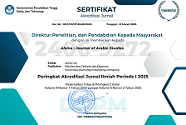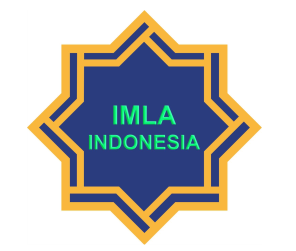Mushkilāt Ta‘līmi al-Lughah al-‘Arabiyyah fī Thailand wa al-Ḥulūl ‘Alaiha
DOI:
https://doi.org/10.21580/alsina.2.1.5395Keywords:
arabic teaching problems, linguistic problems, non-linguistic problems, “songserm wittaya kuttao” school thailandAbstract
The present research aims to describe linguistic and non-linguistic problems in Arabic learning process at “Songserm Wittaya Mulnithi Kuttao”, Thailand and to offer alternative solutions for both. This research uses descriptive qualitative research methods. The result of this research are linguistic and non-linguistic problems; the linguistic problems are the difficulty in pronouncing some Arabic letters, the presence of tashrif in Arabic, and the differences in sentence arrangement and the non-linguistic problems are the learning method I used did not have any variation, the learning media I used did not have any variation, and the students are not motivated to learn Arabic. The alternative solutions to the linguistic problem are the repeating of Arabic letters that are different by Siam language for phonology problems, simplify the material of binyah kalimah and the material of mawaqi’ al i’rob for morphology problems, the giving of patterns of jumlah ismiyyah and jumlah fi’liyah and their examples for syntax efficiency problems. The alternative solutions to the non-linguistic problem are the use of learning methods that are varied and in accordance with the learning objectives, student conditions, and the material taught for the problems in the learning method, the use of learning media that are varied for the problems in the learning media, developing students' enthusiasm by learning Arabic for the problems in students.
Downloads
References
الحجازي، محمود فهم. 1966. مدخل إلى علم اللغة. القاهرة: دار الثقافة.
الخولي، محمد علي. 1989. أساليب تدريس اللغة العربية. الرياض: مكتبة الفرزدق.
روسادي، أحمد تيتو. 2018. دوافع الطلاب في تعلم اللغة العربية ودور المعلم في ترقيتها.
Jurnal Izdihar: Journal of Arabic Language Teaching, Lin-guistics, and literature، 1 (1): 65—78.
Ainin, Moh. 2013. Metodologi Penelitian Peningkatan Kuali-tas Pembelajaran Bahasa Arab. Malang: CV Bintang Sejahtera.
Ainin, Moh. 2016. Metodologi Penelitian Bahasa Arab. Ma-lang: CV Bintang Sejahtera.
Aqib, Zainal. 2015. Model-Model, Media, dan Strategi Pem-belajaran Kontekstual (Inovatif). Bandung: CV Yrama Widya.
Arikunto, Suharsimi. 2013. Prosedur Penelitian: Suatu Pen-dekatan Praktik. Jakarta: PT Renika Cipta.
Ary, D., Jacobs, L.C., & Razaiveh, A. 1993. Pengantar Penelitian dalam Pendidikan. Terjemahan Arief Fur-chan. Surabaya: Usaha Nasional, 2002.
Baisa, Zaky. 2015. Problematika Linguistik dan Non Linguis-tik Pembelajaran Bahasa Arab Di MA Darul Ulum Mu-hammadiyah Galur Kulon Progo Yogyakarta. Skripsi tidak diterbitkan. Yogyakarta: FTK UINSUKA.
Fahrurrozi, Aziz. 2014. Pembelajaran Bahasa Arab: Prob-lematika dan Solusinya. Arabiyat Jurnal Pendidikan Bahasa Arab dan Kebahasaaraban, 1(2): 163—179.
Ghony, M. Djunaidi. & Almanshur, Fauzan. 2012. Metode Penelitian Kualitatif. Yogyakarta: Ar-Ruzz Media.
Hidayat, N.S. 2012. Problematika Pembelajaran Bahasa Ar-ab. Jurnal Pemikiran Islam, 37 (1): 82—89.
Matsna, Moh. 2002. Problematika Pengajaran Bahasa Arab di Indonesia dan Pemecahan Masalahnya. Al-Hadharah: Jurnal Bahasa, Sastra, dan Budaya Arab, 2(1), 47—57.
Morissan. 2016. Metode Penelitian Survei, Cetakan 4. Jakar-ta: KENCANA.
Nazir, Moh. 2009. Metode Penelitian. Jakarta: Ghalia Indo-nesia.
Pohchaeh, Sareena. 2013. Problematika Pembelajaran Ba-hasa Arab Siswa Kelas VIII Madrasah Darasat Witya Narathiwat Thailand. Skripsi tidak diterbitkan. Yogya-karta: FTK UINSUKA.
Santoso, Moh. Amin. 2011. Faktor Linguistik dan Non-Linguistik dalam Pembelajaran Bahasa Arab di Indo-nesia. ¬Al-Arabi: Jurnal Bahasa Arab dan Pengaja-rannya, 9(2), 85—95.
Downloads
Additional Files
Published
How to Cite
Issue
Section
License
Copyright
The copyright of the received article shall be assigned to the publisher of the journal. The intended copyright includes the right to publish the article in various forms (including reprints). The journal maintains the publishing rights to published articles. Authors are allowed to use their articles for any legal purposes deemed necessary without written permission from the journal, but with an acknowledgment to this journal of initial publication.
Licensing
In order for Alsina: Journal of Arabic Studies to publish and distribute research articles, the editors need publishing rights (transferred from author to publisher). This agreement relates to the transfer/publishing copyright license to Alsina: Journal of Arabic Studies but the authors still have significant rights to use and share their published articles.
Alsina: Journal of Arabic Studies supports the need for writers to share, disseminate and maximize the impact of their research and their rights on any database. As a journal article writer, you have the right to various uses of your articles, including that by the institution or company where you work. Copyright can be used without the need for special permission. Authors who publish articles in the Alsina: Journal of Arabic Studies have broad rights to use their work for teaching and scientific purposes without requesting permission, including:
- Use by the author for lectures, presentations, or conferences, with distribution of copies to participants;
- Distribution to colleagues for research use;
- Use in compilations of the author's subsequent work;
- inclusion in a thesis or dissertation;
- Reuse of sections or excerpts from articles in other works (with full acknowledgment of the final article);
- Preparation of derivative works (other than commercial purposes) (with full acknowledgment of the final article);
- Voluntary posting on open websites operated by authors’ or writers' agencies for scientific purposes
When submitting a manuscript, authors do so on the understanding that if accepted for publication, the copyright for publishing (publishing right) of the article shall be assigned/transferred to Alsina: Journal of Arabic Studies.
Authors whose articles are accepted for publication will receive confirmation via email and sent a Copyright Transfer Agreement.


 Accreditation
Accreditation 
 In Collaboration with
In Collaboration with 

 Visitors
Visitors  Article Template
Article Template





